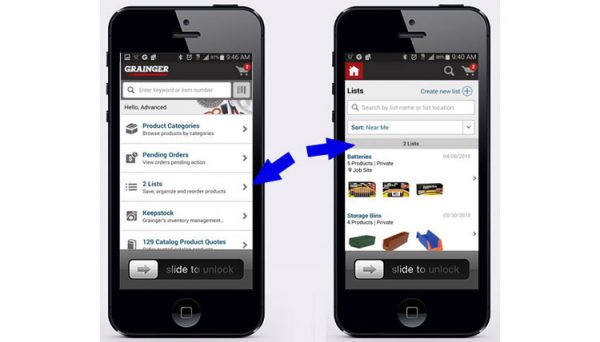Delivering seamless, consistent, and engaging experiences starts with a customer-centered digital strategy. This ongoing series explores the characteristics that make up a great digital strategy and how to deliver powerful brand moments that solidify customer loyalty and drive differentiation for your organization.
Mobile technology – and the role it plays in our lives – continues to evolve. Mobile makes our always-on, connected world possible, and it’s fundamentally changing how we do almost everything.
For marketers, the mobile evolution begs a shift from creating mobile-first experiences to mobile by design. Consider these recent stats:
- This year consumers will spend more time on mobile than watching TV
- Last year 52% of all web traffic originated from mobile phones, up from 50% in 2017
- Among 3.75 billion internet users worldwide, 86% use a mobile phone to go online
As time spent on mobile increases, mobile must be embedded into each decision you make as a business. Your digital strategy, mobile strategy, and marketing strategy should be one and the same.
To understand how critical mobile is for your digital strategy, I’ll explore new ways to think about mobile, opportunities created by the mobile evolution, and highlight examples of brands taking mobile to the next level.
The Shifting Mindset About Mobile
[perfectpullquote align=”right” bordertop=”false” cite=”” link=”” color=”” class=”” size=””] “Most companies recognize mobile’s importance in the customer journey, and yet many still struggle with how to best execute mobile within their digital strategies.”[/perfectpullquote]
Mobile is the channel to consider when making digital investments precisely because of the “mobility” aspect. It has evolved from entertainment to getting business done – whether in the office, at home on the couch, down the street at your local coffee shop, or waiting to catch a plane. Mobile is also the largest source of traffic to a brand’s digital properties in nearly every industry, according to our latest study Mobile vs. Desktop 2018 (published 2019).
Not considering mobile as the key place to acquire, engage, and retain customers is a mistake. However, where do you make the next mobile investment to move the needle? Another native app? A PWA? More dollars into digital marketing focused on mobile?
Here’s the good news: mobile technologies and low-code mobile frameworks allow for faster development and optimizations, and they have improved significantly. You can easily take advantage of platforms that didn’t exist three to five years ago to leapfrog the competition (in mobile) without spending 100% of your budget.
The pace of innovation and rising customer expectations is relentless. Future-proof your CX with a customer-focused digital strategy while making sure that mobile is the cornerstone of that strategy.
Opportunities Beyond Apps and Responsive Sites
Considering the impact of mobile on marketing, your company likely has a responsive website, sends responsive emails, and may invest in mobile-specific marketing campaigns. But, mobile-first marketing approaches are table stakes in 2019.
The next step, especially for consumer brands, is to deliver deep personalization and relevant experiences across mobile, which should now include voice and ‘phygital’ location considerations. For example, a customer using the REI mobile app to shop for a tent also happens to be within a mile of the nearest store. The retailer can correlate location with inventory data and send a push notification that lets the customer know the item is available at the store.
What about B2B? The adoption of mobile is slow relative to B2C. There are additional considerations for B2B mobile experiences, such as authentication, account security, offline access, and content and product information availability for different customers. Don’t forget – the mobile experiences delivered by consumer brands have shaped B2B customer expectations. Buyers in B2B demand access to the types of interactions they enjoy as consumers. Not delivering on those expectations increases the risk of losing their business.
The mobile evolution for B2B has unlimited growth potential. In fact, B2B enterprises currently using mobile to engage customers report more than 40% of their revenue is driven by mobile. It “speeds up time to purchase, particularly in more complex transactions, and a positive mobile user experience increases repurchase rates,” according to BCG.
Examples to Follow: Brands Embracing Mobile by Design
Consumer/retail
Sephora takes full advantage of mobile in effective, customer-centric ways. The beauty retailer considers mobile as a key aspect of the customer journey, using it to “drive the customer into the store and online experience… creating engagement through various interactions across channels.”
Among the app’s standout features is a foundation finder, which recognizes skin tone via your camera, to recommend the best foundation. Or, you can quickly create a color swatch that complements your complexion and virtually try on various eye shadows, eye liners, lipstick, and more. If you like what you see, then you can save the look, head to the nearest store to purchase the items, or buy them directly through the app.
B2B
Grainger, a B2B distributor of office and industrial supplies, is another stellar example of a brand that’s incorporating mobile into its business. Its native app offers “location-based lists” that allow buyers to find and purchase products based on their location or proximity to a warehouse. Buyers can also sort available products by quickest delivery date or nearest branch for pickup. If a buyer opts for pickup, the app pulls and sends turn-by-turn directions to the closest location.

Image credit: Grainger
Getting Started with Your Mobile Strategy
[perfectpullquote align=”right” bordertop=”false” cite=”” link=”” color=”” class=”” size=””]”Mobile is everything, and it’s a concept that should be owned by the entire organization.”[/perfectpullquote]
One of the major hurdles to overcome is the organization’s view of mobile. Many still consider it to be a precious standalone platform. Instead, business leaders should shift their mindset as mobile is the standard device used by customers. They also must think about mobile investment as a first step in componentizing features and functions delivered on any device, anywhere, based on customer needs.
Making the shift from a mobile-first mentality to mobile by design is challenging. If your organization still thinks mobile-first, you may hear questions such as: “Should we build a native or progressive web app? Should we optimize our responsive site?”
Put Your Customer First
Rather than letting specific technologies influence your decision, think about mobile from your customers’ perspective. What are they trying to do? Consider the average consumer’s behavior:
- 46 times a day – how often the average person checks his/her phone
- 50% of mobile search is directed at finding local businesses
- 57% of consumers wouldn’t recommend businesses with a poor mobile experience
At a minimum, your mobile strategy should understand these macro-trends so you deliver an experience that will address customers’ primary needs when using their mobile devices, which is a large part of the day.
Expand the Ownership for Mobile
Furthermore, if your company maintains the idea that one internal team “owns” mobile, this mindset also needs to change. Mobile is everything, and it’s a concept that should be owned by the entire organization.
Your strategy should rely on customer data and qualitative customer insights to drive ideation and prioritization of mobile-by-design investments. A customer-focused mobile strategy will open the door to conversations with your IT and development teams about business requirements. Then, they can help you evaluate and select platforms that support the best experience for customers.
A good starting point for your mobile strategy is to assess CX maturity across your organization. Read more about our CX IQ.
Reach New Heights with Mobile
If your company currently delivers a mobile experience – either through an app or responsive website – it’s time to take it to the next level.
Make sure your integration strategy is mobile-by-design. Data should be captured and shared across experiences and devices. This data should also be used to drive better experiences through AI, personalization, or localization. In some cases, more mature mobile strategies will create the need for a new customer data strategy.
For responsive sites, a variety of new design technologies and platforms can elevate the customer experience. These technologies can deliver relevant, optimized content while decreasing development and maintenance time required of your IT support team. Consider progressive web apps or hybrid mobile technologies that allow you to deliver mobile-by-design experiences across devices or even desktops.
Learn more about evaluating your current mobile experience.
Final Takeaway
Mobile is the platform to consider as you build a digital strategy and invest in digital platforms. Among the other essentials covered in this series – AI, smart personalization, product as a channel – each of these should function within the context of mobile.
Furthermore, your mobile strategy shouldn’t be isolated from your digital strategy or marketing strategy. These considerations are all part of the same strategy.
Creating stand-out digital customer experiences that attract, engage, and retain customers is a tall order. Perhaps you’ve already done some of the foundational work, and you need help with the next step.
When working with clients, we help make sure you know your customers and understand their journeys. Through design-thinking tools, industry research, and pragmatic ideation to execute from end-to-end, you will have what it takes to deliver experiences that surprise and delight your customers
Ready to get started with your digital strategy? Dive in for more resources.



